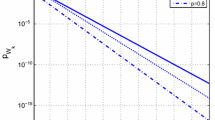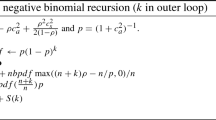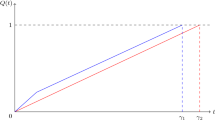Abstract
In this paper, we show that the discrete GI/G/1 system can be easily analysed as a QBD process with infinite blocks by using the elapsed time approach in conjunction with the Matrix-geometric approach. The positive recurrence of the resulting Markov chain is more easily established when compared with the remaining time approach. The G-measure associated with this Markov chain has a special structure which is usefully exploited. Most importantly, we show that this approach can be extended to the analysis of the GIX/G/1 system. We also obtain the distributions of the queue length, busy period and waiting times under the FIFO rule. Exact results, based on computational approach, are obtained for the cases of input parameters with finite support – these situations are more commonly encountered in practical problems.
Similar content being viewed by others
References
M.H. Ackroyd, Computing the waiting time distribution for the GI/G/1 queue by signal processing methods, IEEE Trans. Commun. 28 (1980) 52–58.
A.S. Alfa, Discrete time queues and matrix-analytic methods, TOP 10(2) (2002) 147–210.
A.S. Alfa, Markov chain representations of discrete distributions applied to queueing models, submitted.
A.S. Alfa and W. Li, Matrix-geometric solution of the discrete time GI/G/1 system, Stochastic Models 17(4) (2001) 541–554.
A.S. Alfa and M.F. Neuts, Modelling vehicular traffic using the discrete time Markovian arrival process, Transport. Sci. 29 (1995) 109–117.
M. Chaudhry, M. Agarwal and J.G.C. Templeton, Exact and approximate numerical solutions of steady-state distributions arising in the queue GI/G/1, Queneing Systems 10 (1992) 105–152.
J.W. Cohen, The Single Server Queue (North-Holland, London, 1969).
S. Dafermos and M.F. Neuts, A single server queue in discrete time, Cahiers Centre Rech. Opér. 13 (1971) 23–40.
A.G. de Kok, A moment-iteration method for approximating the waiting-time characteristics of the GI/G/1 queue, Probab. Engrg. Inform. Sci. 3 (1989) 273–287.
A.A. Fredericks, A class of approximations for the waiting time distribution in a GI/G/1 queueing system, Bell System Tech. J. 61(3) (1982) 295–325.
I. Frigui, A.S. Alfa and X. Xu, Algorithms for computing waiting time distributions under different queue disciplines for the D-BMAP/PH/1, Naval Res. Logist. 44 (1997) 559–576.
W.K. Grassmann and J.L. Jain, Numerical solutions of waiting time distribution and idle time distribution of the arithmetic GI/G/1 queue, Oper. Res. 37 (1989) 141–150.
W.K. Grassmann and D.P. Heyman, Computation of steady-state probabilities for infinite-state Markov chains with repeating rows, ORSA J. Comput. 5 (1993) 292–303.
C.M. Harris, A note on mixed exponential approximation for the GI/G/1 waiting times, Comput. Oper. Res. 36 (1985) 285–289.
G. Haßlinger, Waiting time, busy period and output models of a server analyzed via Wiener–Hopf factorization, Performance Evaluation 40 (2000) 3–26.
A.G. Konheim, An elementary solution of the queueing system GI/G/1, SIAM J. Comput. 4 (1975) 540–545.
G. Latouche and V. Ramaswami, Introduction to Matrix Analytic Methods in Stochastic Modeling ASA–SIAM Series on Applied Probability (1999).
D.M. Lucantoni, New results on the single server queue with a batch Markovian arrival process, Stochastic Models 7 (1991) 1–46.
M.F. Neuts, Matrix-Geometric Solutions in Stochastic Models (John Hopkins Univ. Press, Baltimore, MD, 1981).
M.F. Neuts, Structured Stochastic Matrices of M/G/1 Type and Their Applications (Marcel Dekker, New York, 1989).
M.F. Neuts, Some promising directions in algorithmic probability, in: Advances in Matrix-Analytic Methods for Stochastic Models, eds. A.S. Alfa and S. Chakravarthy (Notable Publications, 1998) pp. 429–443.
T.J. Ott, On the stationary waiting-time distribution in the GI/G/1 queue, I: Transform methods and the almost-phase-type distributions, Adv. in Appl. Probab. 19 (1987) 240–265.
J. Ponstein, Theory and solution of a discrete queueing problem, Statist. Neerlandica 20 (1974) 139– 152.
V. Ramaswami, Stable recursion for the steady state vector for Markov chains of M/G/1 type, Stochastic Models 4 (1988) 183–188.
B.V. Rao and R.M. Feldman, Numerical approximations for the steady-state waiting times in a GI/G/1 queue, Queueing Systems 31 (1999) 25–42.
D. Shi, J. Guo and L. Liu, SPH-distributions and the rectangle-iterative algorithm, in: Matrix-Analytic Methods in Stochastic Models, eds. S. Chakravarthy and A.S. Alfa, (Marcel Dekker, New York 1996) pp. 207–224.
D. Shi and D. Liu, Markovian models for non-negative random variables, in: Advances in Matrix Analytic Methods for Stochastic Models, eds. A.S. Alfa and S. Chakravarthy (Notable Publications, 1998) pp. 403–427.
K.S. Trivedi, Probability and Statistics with Reliability, Queueing and Computer Science Applications (Prentice-Hall, Englewood Cliffs, NJ, 1982).
R.L. Tweedie, Operator-geometric stationary distributions for Markov chains, with applications to queueing models, Adv. in Appl. Probab. 14(2) (1982) 368–391.
T. Yang and M.L. Chaudhry, On the steady state-state queue size distributions of the discrete-time GI/G/1 queue, Adv. in Appl. Probab. 28 (1996) 1177–1200.
Author information
Authors and Affiliations
Rights and permissions
About this article
Cite this article
Alfa, A.S. Combined Elapsed Time and Matrix-Analytic Method for the Discrete Time GI/G/1 and GIX/G/1 Systems. Queueing Systems 45, 5–25 (2003). https://doi.org/10.1023/A:1025653200299
Issue Date:
DOI: https://doi.org/10.1023/A:1025653200299




